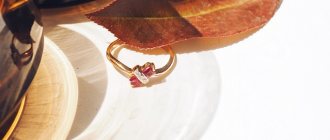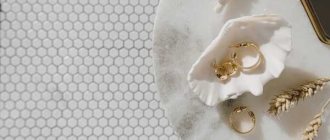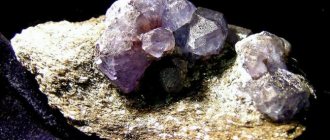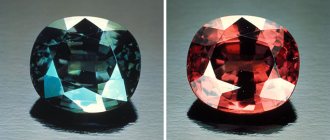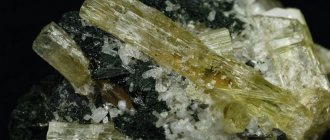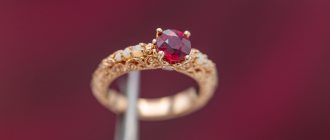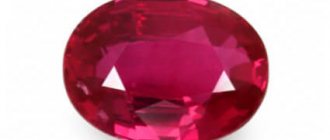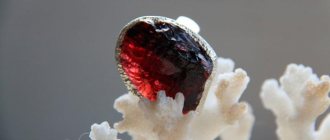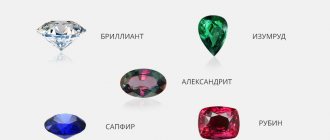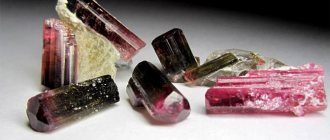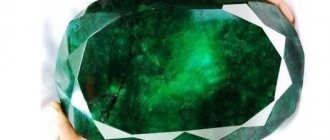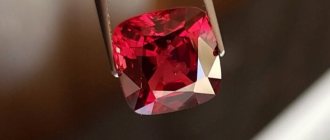Ruby? – rare, expensive, beautiful, precious stone. Ruby jewelry is in great demand today among men and women. It’s not surprising, because jewelry with a gem looks luxurious and elegant, and the energy of the stone can give its owner strength, power and love.
What is a ruby
Ruby is the twin brother of sapphire, both of them come from the corundum family. Their base is transparent aluminum oxide, and the red color of the ruby is given by an admixture of chromium. Red corundums are called rubies; the name refers specifically to the color. All other corundums are sapphires, they can be the usual blue color, or have yellow, green, orange and other colors, that is, they can be fancy.
In terms of hardness, corundum is only 1 point worse than diamond (9 on the Mohs scale), so it is perfect for creating jewelry that you will never part with. Since the value of the stones is high, most often you can find gold jewelry with rubies, sometimes platinum. In silver, you will most likely be offered synthetic nanorubies, since the value and strength of natural stones makes it impractical to inlay them into soft silver.
Varieties of rubies
Rubies come from all over the world and are available in a variety of shades. However, they are divided into specific types depending on the country or region in which they are mined. Common types include:
- Burmese rubies. Stones from Burma, now Myanmar, are generally considered to be among the most coveted in the world. They have a dark red color that stands out and can look special.
- Thai rubies. Thai has a deeper, but less saturated color than Burmese, and is considered second in quality. They typically contain higher levels of chromium and iron, which contribute to their unique hue.
- African rubies. Corundums from African countries such as Kenya and Mozambique are dark red or red-violet. Dark red African ones are popular due to their rich color.
- Pigeon's blood rubies. Corundums of the “pigeon’s blood” shade are especially desirable and valuable. They are bright red in color with a soft purple tint. In the light they appear dark red.
Pigeon's blood ruby
What types of gold jewelry with ruby are there?
The most popular jewelry with rubies in gold are earrings, rings and pendants. Often, red corundums become neighbors of diamonds; such a union allows you to maximize the beauty of a ruby: even a small stone looks very bright, as in this narrow gold ring with ruby and diamonds.
Rubies are cut using the same methods as diamonds and are extremely rarely found in cabochon form. Most common:
- classic round brilliant cut;
- oval, which can be made to order,
- “marquises”, as in gold earrings, where the ruby “marquises” turned into flower petals.
Ruby jewelry for women is most often made in red gold; this color of the precious metal suits the red stone most. Rubies in white metal look simpler, to be admired, they must be truly luxurious.
A 1-carat ruby is rare in nature and such specimens are expensive, so jewelry designers prefer to place several stones side by side to visually enlarge the insert, as in this ring with 3 rubies and diamonds, or in these gold earrings.
Ruby - stone of passion
Raw Ruby Crystal
Ruby is a red gemstone that varies in color from light pink to blood red. Ruby is a variety of the mineral corundum (aluminum oxide). By the way, sapphire is also a type of corundum. The color is caused mainly by chromium. Its name comes from the Latin word "rubber", meaning "red". Natural rubies are extremely rare, but synthetic rubies can be produced quite easily. Ruby is considered one of the four highest gemstones, along with sapphire, emerald and diamond.
Ruby is dedicated to the Sun. This is a stone of special magical power, a stone of testing, mastery of the forces of energy. It will help you overcome the forces of darkness and fight fear. This is a stone of power. This stone is best worn by those who have already achieved something.
In ancient times, rubies were credited with various healing properties: to stop bleeding, preserve memory, give vigor and joy, and courage. It was believed that ruby could protect against serious illnesses and arouse love passions. Ruby is recommended to be worn as a healing stone for people who suffer from low blood pressure. When wearing the stone, sleep, general condition and appetite improve, lost strength returns, but you cannot wear the stone constantly, because it takes a lot of energy.
Other names for the mineral and its varieties: noble red corundum, ratnanayana, manikia, yakhont, carbuncle.
If you could talk to Bangkok jewelery dealers and win them over, they would tell you how rubies take centuries to ripen and take on color underground. Perhaps they would tell you the ancient legend about the terrible dragon Naga, who laid three magical eggs. From the first came the king of Burma, from the second the great Chinese emperor, and from the third all the rubies, those that people have already discovered and those that are yet to be found.
Rubies are mined in Africa, Asia, Australia, Greenland, Madagascar and North Carolina. They are most often found in Myanmar (Burma), Sri Lanka, Kenya, Madagascar and Cambodia, but they have also been found in the US states of Montana, North Carolina and South Carolina. The Mogok Valley in Upper Myanmar has produced some of the world's finest rubies, but, in recent years, very few good rubies have been found there. The unique color of Myanmar rubies is described as "dove's blood". They are known in the trade as “Mogok” rubies. In central Myanmar, the Mong Hsu region also produces rubies. The last ruby deposit to be found in Myanmar is located in Nam Ya. In 2002, rubies were found in the Waseges River region of Kenya.
It happens that a ruby crystal contains microinclusions of “needles” of rutile (mineral, titanium dioxide), the thickness of which is commensurate with the wavelength of light. “Needles” give the stone a soft silky shine and iridescence. Using “needles” the effect of a cat’s eye or asterism is created.
Asterism is an optical effect observed in processed stones with a spherical or other curved (parabolic, ellipsoidal) surface, the so-called cabochons. In these cases they talk about star rubies (asterixes).
Star rubies are very rare. They are judged on beauty and color intensity rather than on clarity. Excellent quality star rubies should have the star located exactly in the middle of the stone and the rays extending to the girdle.
Such rubies are polished in the form of a cabochon, when moving it a six-rayed star slides on the surface of the stone.
The biblical sage king Solomon wore a ring with such a stone, which emitted 6 pearl-colored rays, on the index finger of his left hand. On one side of the ring it was written “All things pass,” and by turning it the other side, one could read “This too shall pass.”
The Ring of Solomon, according to a folk tale widespread in the East, is kept in the tomb of this biblical king and is guarded by some fantastic dragons. In addition, where this tomb is located is also unknown to anyone; but everyone knows that the lucky person who managed to take possession of this ring would become nothing more or less than the owner and ruler of the entire world and billions of ethereal forces inhabiting the Universe.
Mages considered the ruby to be a blood clot of the Dragon, capable of giving unlimited power and having an irresistible effect on people. It is no coincidence that ruby was the favorite stone of the Russian bloodsucker Tsar Ivan the Terrible. Many people believe that rubies give mental strength and courage to their owner and strengthen their heart. Ruby counteracts poison and sadness, curbs lust, drives away bad dreams, enlightens the mind, protects the body from danger, and if danger is near, warns of it by becoming darker.
In India, ruby was one of the most revered magical stones. He was considered the best exponent of the element of Fire and a powerful concentrator of the strong principle of Yang. There is an opinion that jewelry with rubies helps concentrate sexual energy. In India, strong wine was known, to which rubies ground into powder were added. It is believed that rubies can inspire a person to great things. In the old days, it was believed that a change in the color of a ruby warned the owner of the jewelry about impending danger.
Sometimes spinels were found together with rubies in the same rocks and were mistaken for rubies. However, beautiful red spinels can approach the average ruby in value. Rubies have a hardness of 9.0 on the Mohs mineral hardness scale. Among natural gemstones, only diamond is harder (10.0 by Mohs definition). Note that the Mohs hardness scale is logarithmic, and a Mohs hardness of 10 is twice as hard as 9. All natural rubies have imperfections, including colored impurities and inclusions of rutile needles, known as “silk.” Gem experts use these needle-like inclusions found in natural rubies to distinguish them from synthetic, chemical stimulants or substitutes. Usually the rough stone is heated before cutting.
Ruby is a red gemstone known to people since ancient times. It has variations in shades and colors, from pink to dark purple with a violet tint. The classic color of a ruby is scarlet, the so-called “pigeon’s blood” color. In Rus' it was called “worm-shaped yacht”, in the east “lal”.
Recently, ruby earrings, each ruby weighing 11 carats, went up for auction. Expected price 1.4-2.5 million.
There is a belief that this stone has healing properties. In the old days, ruby ground into dust was added to wine and given to people who were weak, pale, and anemic to drink. This gave them a pink blush on their cheeks and a lively sparkle in their eyes, which were dull from ill health.
Paracelsus treated plague and bubonic ulcers with ruby. The red sparkling stone relieves depression and melancholy, strengthens the immune system, makes the brain clear and the heart strong. Gives faith and energy.
This is a stone of brilliance, vanity, victory, very strong passions and ardent love.
The first information about rubies dates back to the 4th century BC and is found in Indian and Burmese chronicles. The rulers of Burma held many titles, one of them was the title "Lord of Rubies". When the king was informed that a wonderful stone had been found, he sent a delegation accompanied by warriors on elephants to fetch it. They were to preserve the huge ruby and bring it to the royal palace with all due honors.
Royal rubies
Danish ruby parure
This parure was first worn by Désirée Clary at the coronation of Napoleon Bonaparte in 1804. Her husband Jean Baptiste Bernadotte was then Marshal of the Empire. The parure then consisted of a necklace, earrings and hair ornaments that represented flowering maple leaves. After her death, she bequeathed this parure to her grandson's wife, Crown Princess Louise, born Princess of Orange-Nassau. She, in turn, gave this parure as a wedding gift to her only daughter Louise, who in 1869 married the future Danish king Frederick VIII.
Presumably it was under Queen Louise that hair jewelry was designed into a tiara, with the ability to transform into brooches and hair jewelry. Unfortunately, I was unable to find a portrait of Louise in this precious parure. Maybe she “didn’t like her very much”, so she didn’t join the Family Foundation. Queen Louise gave the parure tiara as a wedding gift to her son Christine's fiancée, Princess Alexandrina of Mecklenburg-Schwerin. After Louise's death, the remaining parts of the parure passed to Queen Alexandrina, who gave the parure to her son Frederick's bride, Princess Ingrid of Sweden, as a wedding gift. Thus, in Denmark, a peculiar tradition of crown princesses wearing this parure has developed. Wanting to continue the tradition, Ingrid bequeathed this parure to her grandson, Crown Prince Frederik. Now his wife Mary wears it.
Ruby parure of the Wittelsbachs
It was commissioned by the master Caspar Rielender by King Ludwig I of Bavaria for his wife Theresa of Saxe-Altenburg in 1830. This magnificent piece consists of a tiara of rubies, diamonds and spinels, as well as two bracelets and a corsage decoration.
The ruby tiara was a gift from King Edward VII and Queen Alexandra to Princess Margaret of Connaught in 1905.
Ruby parure of Orange
Ruby Burmese Tiara
Egret (decoration for a woman's headdress or hairstyle) of Marie Antoinette
Rubies Grace Kelly
Tiara "Ruby Lotus"
Tiara of Grand Duchess Maria Alexandrovna of Edinburgh.
Alexander II ordered this ruby set from the court jeweler Bolin as a wedding gift to his daughter Grand Duchess Maria Alexandrovna, who in 1874 married the second son of Queen Victoria and Prince Consort Albert, Duke Alfred of Edinburgh, from 1893 Duke of Saxe-Coburg and Gotha. The Duchess and Grand Duchess Maria Alexandrovna gave this set to her daughter Alexandra for her wedding with Duke Ernst of Hohenlohe-Lang. Their son Godfried married the Greek Princess Margaret of Battenberg Mountbatten (elder sister of the Duke of Edinburgh, who is married to Elizabeth II) and she wore these treasures (for example, at the wedding of Juan Carlos and Sofia in 1962). The set was sold at auction in 1989, after the death of Margarita (1981)
Tiara de Torby
The history of this tiara is connected with the beautiful love story of the descendants of the Romanovs and Pushkins. His name was Grand Duke Mikhail Mikhailovich, hers was Sofia Merenberg. He is the grandson of Nicholas I, she is the granddaughter of Alexander Sergeevich Pushkin. This decoration seems to personify the grandeur and splendor of the Imperial family and the grace and lightness of the verse of the great poet of Russia.
Grand Duke Mikhail Mikhailovich and Sophia Merenberg, Countess of Thorby
Their marriage was impossible and was considered morganatic in Russia. He cost the Grand Duke his service, title and the opportunity to live in his homeland. In 1891, Grand Duke Mikhail Mikhailovich married Sophia Merenburg, daughter of Prince Nicholas of Nassau and Natalia Alexandrovna Pushkina, daughter of the Great Poet. Presumably the tiara became a wedding gift from the Grand Duke to the bride.
The jewelry was made by the famous jewelry house Bolin from gold and silver, adorned with 70 cabochon-cut rubies and 822 old-cut and rose-cut diamonds. The tiara has the shape of a Russian kokoshnik, the main decorative elements are stars and crescents, lilies, trefoils, and the central element is an order star with a heart in the center. The tiara is convertible - many of its elements can be taken apart. Almost each of them can become a brooch, and when combined, it is possible to create earrings or even a necklace. In terms of style and class of execution, this tiara can be compared with the ruby diadem of Grand Duchess Maria Alexandrovna, daughter of Alexander II.
The Grand Duke and his wife, who received the title of Countess de Torby from the Grand Duke of Luxembourg, settled in England. They had two daughters Anastasia and Nadezhda and a son Mikhail. Both of their daughters married into the English family aristocracy and were known as Lady Zia and Lady Nada.
It was Lady Nada, Marchioness of Milford Haven, who inherited this tiara from her mother.
Ruby Tiara Ashraf
Made for the coronation of the last Shah of Iran in 1967 for his twin sister Ashraf, by jewelers Van Cleef & Arpels Princess Ashraf was the first in the royal Iranian family to appear without a headdress with a veil. The tiara is in Tehran, in the central bank, because the Shah's family was prevented from removing the jewelry during the 1979 revolution.
Iranian ruby tiara
Russian ruby tiara
Thai tiara, rubies and diamonds. The last time it was shown in Europe was during the royal visit to Holland.
a ruby necklace with a pendant brooch belonged to Countess Alina de Romanones (before that it was in the box of the Duchess of Windsor)
"Polish Eagle"
Hairpin "Polish Eagle", kept in the Louvre
Monomakh's hat
And, of course, one cannot fail to mention the famous “Monomakh’s Cap”, on which rubies occupy the crowning place. It is known that it served as the most important wedding attribute of the Russian tsars from 1498 until the reign of Peter the Great.
In the crown of Catherine the Second, there was a ruby the size of a dove's egg. Gift from the Swedish king.
Monomakh's hat
Lady Wallis Rubies
This stunning ruby set was given by the Duke of Windsor to his wife Wallis.
Lady Diana's Ruby Set
Tiara of the Duchess of Cornwall (according to some sources, the rubies in it are synthetic)
These rubies and diamonds belonged to Mary, Duchess of Roxburgh, and were probably purchased from Garrards (a British jewelery house since 1735).
Rubies Liz Taylor
Elizabeth Taylor loved this stone very much.
Cartier Ruby set. The Cartier ruby and diamond set was a gift from Mike Todd in August 1957. Married to producer Mike Todd, Elizabeth Taylor was one day swimming in the pool at their villa in Saint-Jean-Cap-Ferrat (France) when Mike suddenly presented her with three Cartier boxes containing jewelry - an amazing ruby set.
Tiara with rubies, mid-19th century. Now in a private collection in Japan
The history of rubies is also marked by blood.
In the century before last, one German adventurer Hermann robbed a Buddhist temple in India. He killed the servant, and removed and carried away several dozen luxurious rubies from the Buddha statue.
Returning to Europe, he sold these stones for huge money to the Habsburg family, who then ruled Austria-Hungary. But he did not have time to use his wealth; he was tracked down and killed by the servants of the robbed temple.
Squabbles and intrigues began in the Habsburg family, as a result of which the rubies went to Maximilian, the younger brother of Emperor Franz Joseph. Maximilian became king of Mexico, but was overthrown as a result of a rebellion and executed at the age of 35.
The rubies were confiscated, but in 1911 the Mexican government decided to transfer them to Maximilian's heirs and sent them to America on a special steamer.
But on the way, the ship collided with a warship and sank, along with jewelry worth $25 million. After the Second World War, in 1949, an attempt was made to examine the sunken ship, but to no avail. In 1975, while trying again to get the treasure, two divers died. And in 1986 it didn’t work out either and ended tragically. Until now, even individual scuba divers are trying to get rubies stolen from Buddha from the bottom of the ocean. But in vain.
Parure with ruby cabochons, turquoise and diamonds, entirely in yellow gold. "Mauboussant". OK. 1970. Large ruby cabochons are used exclusively for their bright color. The detachable pendant will become one of the most quintessential 1970s design elements.
Limelight Party necklace from Piaget in yellow gold with rubies, pink tourmalines and yellow and orange sapphires.
Antique brooch with rubies and pearls. Second half of the 19th century.
Mughal rubies
At the Mughal court, jewelry was an integral part of court costume. Moreover, the courtier was obliged not only to dress himself according to his position and status, but also to ensure an appropriate standard of clothing for all family members and even servants. Some jewelry served as a distinctive sign of royal favor, such as a gold ankle bracelet or a toe ring - gold on the feet was only allowed to be worn by the emperor and those whom he allowed. Therefore, when one of the courtiers was awarded this honor, it was a sign of the emperor’s special favor and aroused the envy of others.
Although gold jewelry, invariably decorated with enamel or precious stones, was popular, the most beloved during Mughal times were beads, necklaces, and garlands of stones. Ruby was the favorite stone, followed by diamonds, emeralds and pearls in popularity. The Mughal treasury was full of these treasures. William Hawkins, who lived at the court of Emperor Jahangir for many years, noted in his notes that the imperial treasury contained 50.4 kg of rubies, 126 kg of emeralds, 37.8 kg of diamonds of at least 2.5 carats in size and 302.4 kg of pearls.
Natural ruby is a very rare and valuable stone, sometimes worth a fortune. Its highest recorded price is $100,639 per carat.
Large rubies are rarer than diamonds. Over a hundred years, from 1870 to 1970, more than three hundred crystals larger than 200 carats were found during diamond mining, and only a few rubies of the same size.
Ring with natural ruby from Burma
Almost all rubies today are treated in some form. Heat treating is the most common practice and rubies that are completely untreated and still of excellent quality command a high price.
Ruby prices are primarily determined by color (the brightest and finest “red,” called “Red Blood of the Dove,” commands a higher price than other rubies of similar quality). After color comes clarity: a diamond-like transparent stone will fetch a high price, but a ruby without any needle-like inclusions will indicate that the stone has been treated in some way. The cut and carat (size) also determine the pricing of a ruby.
Methods for determining the authenticity of a ruby
:- If a ruby is placed in a glass vessel, a reddish color will emanate from it. If a ruby is placed in a glass of cow's milk, the milk will take on a pinkish color, whereas it is usually yellowish in color;
- The ruby appears dark red when viewed from one angle, and pale when viewed from the reverse side;
- A crack in a real ruby will not shine. It will have a zigzag shape, whereas a crack in an imitation ruby will be straight, clearly visible and shiny;
— Bubbles are rare in real rubies; they are round and have the same color as the stone, but in imitation stones the bubbles are round, open, white and sometimes empty;
– A real ruby placed on the eyelid remains cooler due to its compact molecular structure. A piece of glass or a fake stone, a synthetic ruby heats up quickly;
— The layers of a real ruby are linear and straight, whereas in fakes they are circular;
— A fake ruby turns orange when placed under an ultraviolet lamp.
Processing methods
So. As has already been written, good quality crystals are rare and cannot meet the demand for cut stones of acceptable quality. Accordingly, in order to satisfy this demand, various methods of refining rubies were invented. I will not touch here on such an ancient and generally accepted method of refining as heating. I repeat, stones that have not undergone any treatment are more expensive than stones treated with heat, but in comparison with other processing methods, heating is like applying makeup (the heating effect is permanent), while other methods are comparable to plastic surgery.
Be-treatment (diffusion)
This processing method allows you to give the stones a redder color. This method uses beryllium, which changes the color of the stone. The effect is permanent, the only thing worth noting is that such a stone cannot be recut. Stones processed using this method are not common. They can be distinguished by their unnatural color (with an orange tint.
Lead Glass Filling
But the vast majority of rubies have undergone this treatment. According to the most optimistic estimates, the share of such rubies is now about 95%. Unfortunately, very often they prefer to keep silent about the fact that a ruby was refined in this way, although the requirement to indicate this type of processing is very strict. Usually they either don’t write anything, or they write Heated (heated, heat-treated, etc.), without indicating that this is not just heating, but heating with glass filling. There is also the designation Treated (processed) - a more honest designation, since this is how glass-filled rubies are usually designated. The question of whether the ruby was filled with glass is very important, since the price of glass-filled rubies and simply heated rubies differs tenfold.
Let’s look at this processing method in more detail to understand why rubies that have undergone this process are cheap and there are so many of them. All the information described below is mainly based on two significant scientific works devoted to this topic, as well as on additional information obtained from analyzing the market for precious stones (rubies), I won’t bother you with names)
So, as already written above, significantly fewer ruby crystals of acceptable quality are mined than the market requires. Moreover, the prices for such stones are very, very high. Accordingly, in order to satisfy the market need for rubies of acceptable quality at a low price, it was necessary to find a method that could significantly improve the quality of the mined ore.
This method was found not so long ago (at the beginning of the 21st century, around 2003-2004). This is not to say that this method was innovative. The fact is that the same ideas and principles were already used in the 90s of the 20th century in attempts to improve the clarity of diamonds. Question: Why are these rubies so much cheaper than rubies processed only by heat? The answer to this question can be found by looking at the raw materials from which these stones are prepared. So, below are three photographs, which show 1 - rubies before, 2 - in the middle and 3 - after processing.
1.
2.
3.
Such stones can contain up to 50% (or maybe more) glass. Glass fills all the cracks, displacing inclusions, making the stone more transparent. The filler can be either colorless or colored (to improve color).
In general, it becomes clear that you can get as many of these rubies as you like, since there are no problems with raw materials. Since the cost of stones depends on their rarity (of course, not only on it, but significantly), the cost of such stones is not high.
I can say even more - the price of such stones is not much more than the price of synthetics, since one of the goals of developing this method was to obtain natural stones that could compete in price with synthetics. Of course, the question of how natural such stones can be considered is quite controversial and everyone decides for themselves, but the fact remains that the community classifies these stones as natural.
Using this method, you can get stones of almost any size, which is why glass-filled rubies weighing 10 carats or more are not uncommon and are quite inexpensive.
How to avoid becoming a victim of deception
Price.
Typically, glass-enhanced stones are cheap, very cheap.
Size.
Rubies of more than one or two carats that have not been filled with glass are very rare, and therefore the likelihood of encountering them is low.
If you see a stone of 1-2 carats, then the probability that it is filled with glass is about 80%. Next you need to look at the price. If the price is less than $100 (of course I’d like to write a higher number - around $150-200) per carat for a carat stone or less than $150 (of course I’d like to write a higher number - around $200-250) per carat for a two-carat stone, then the probability that there was treatment rises to 95%.
Stones from 3 carats, in almost 99% of cases, are filled with glass. Of course there are unprocessed ones, but the price is mind-blowing. The price for a 5-carat stone is more than $100,000. And this is a very, very good price.
It can also be noted that stones filled with glass give off peculiar flashes of light (orange) in those places where they are filled with glass. But in order to see them you need to have a stone in your hands and have a little experience in observing them.
What else do you need to know
In principle, this type of processing is considered permanent, but you need to know that such stones cannot be heated to high temperatures (from 700 degrees). In other words, when ordering a product with such a stone from a jeweler, you must warn him about this. Also, these stones cannot be cleaned in an ultrasonic bath. Moreover, since the method is quite young, and there are no stones that live with such treatment for at least 10 years, the evidence that this method is durable is theoretical.
By the way, star stones are processed in the same way.
So... 95% of all rubies on the world market are glass-filled, led-glass filled. About 1% of all stones are beryllium (usually large rubies, but recently small rubies have appeared, calibrated in size, with a magnificent machine-cut diamond cut), “beryllium treated”. The latter can be identified by their specific brightness and orangish tint. 4% of all rubies underwent one or another heat treatment without introducing foreign elements into the stones. The number of rubies that have not undergone any treatment, pure and bright, saturated, is measured only in thousands, not even tens of thousands, but only thousands!!! The cost of untreated rubies is comparable to the cost of very good diamonds; such rubies are many times rarer stones than diamonds!
If anyone still has synthetic Soviet-cut rubies (stones made in the USSR) in their jewelry, do not rush to get rid of them. You have an example of a beautiful machine-cut stone and a rare example of a valuable synthetic stone. Now you can’t just buy them in a jewelry store. Today, prices for faceted synthetic corundums, rubies and sapphires for jewelry are many times higher than the prices for traditional colorless and colored cubic zirconia (synthetic cubic zircons), although they are noticeably cheaper than the prices for natural gemstones of the corundum group.
Therefore, I would like to advise you to be very careful about the descriptions of rubies provided by the vast majority of sellers. In general, the trend is this: the cost of glass rubies cannot exceed $25-30 per carat. In very rare cases, with a small (no more than 10%) degree of glass filling and first-class clarity and color, the cost of such stones can be comparable to the price of completely “non-glass” rubies. The cost of heated rubies without glass cannot be less than $100 per carat, even if the quality is very low. These rubies, when clear to the eye, start at $500 per carat and up, depending on color and weight. The cost of untreated rubies most often resembles not the price, but a telephone number with all international and long-distance codes.
High-quality rubies have always been and remain extremely rare. The most famous ruby deposits are located in Burma, Vietnam, Tanzania, Kenya, Madagascar, Thailand and Cambodia. Rubies are also found in Colombia, Afghanistan, Pakistan, India and the USA.
Today, in terms of production volume from their deposits, the absolute leaders in the ruby market are Burma, Tanzania and Madagascar. Not in quantity, but in quality of material, they are followed with a significant lag by India, Thailand, and Vietnam. More recently, Mozambique was added to this list, but so far, despite the very decent quality of the stones, their quantity is small.
What is the value of natural ruby
The first stone synthesized was ruby - scientists learned to reproduce it in the laboratory back in 1837. Therefore, it is not surprising that synthetic (hydrothermal) rubies can now be found more often than natural ones. Should I look for stones of natural origin? There are at least 3 reasons to buy a natural ruby.
This is a gem
The quality of ruby synthesized in the laboratory is no worse than natural ruby. The synthetic analogue has the same structure and composition as natural corundum, but, unlike the latter, it grows in the laboratory in a few days. Like everything artificial, it is perfect - there are no flaws in it that can be seen in any stone of natural origin, imperfections that give individuality and make it special. And yet, only a ruby of natural origin can be called a precious stone. This provision is enshrined in Federal Law No. 41 “On Precious Metals and Precious Stones” dated March 26, 1998.
It's a smart investment
Synthetic rubies are several times cheaper than natural rubies, and they are also easier to cut due to their uniform structure. If you wanted to buy a 1-carat natural ruby, you would pay about 350 times the price for a synthetic corundum of the same size. The production costs of jewelry with nanorubies are lower, and the price on a jewelry counter is practically no different from the cost of jewelry with natural rubies. So, when buying jewelry with nanorubies, you always overpay, and they are unlikely to become family jewelry.
This is a talisman
If you believe in the power of talisman stones, you should choose jewelry with natural ruby, because both lithotherapists and fans of the magic of stones unanimously claim that only natural stones have special energy and magical properties. You can believe them or not, but the electron microscope proves that each gemstone has a unique supramolecular structure.
Magic properties
Ruby is considered a stone of power, so it helps to raise the authority of its owner and grow in his career.
The stone symbolizes love for individuals and for the world around us as a whole, helps to show compassion, understanding, evokes a feeling of selflessness, self-sacrifice, teaches to love and create goodness and harmony. Rubies are often given to loved ones, emphasizing your passionate and strong love for them. In its mystical meaning, ruby protects from the evil eye and damage, repels enemies and ill-wishers.
IMPORTANT! It should be taken into account that ruby enhances the prevailing qualities of a person: it makes good people kinder, and evil people angrier. Deceitful people or people with ill-willed thoughts may suffer misfortune from this stone.
People with superpowers - psychics and sorcerers - often use the magical power of ruby.
Where to buy jewelry with natural rubies
You can find a lot of advice on how to distinguish a natural ruby. But let's be realistic: it is unlikely that you will come to a jewelry store with lemon juice or take gold jewelry out of the store before purchasing it to check whether the color of the stone changes in the sun. The smartest decision is to buy ruby jewelry from a store you trust. The jewelry tag will indicate the origin of the insert; legislation requires that stones of artificial origin be marked, for example, “ruby synthetic.”
Diva jewelry stores are perhaps the best place to buy jewelry with natural rubies in St. Petersburg, because the Diva brand specializes in creating gold jewelry with natural stones. We combine modern technologies with the best traditions of the old school of jewelry, so that within our walls you will find jewelry worthy of becoming a family heirloom. A nice bonus is affordable prices from the manufacturer. Choose the real thing!
buy earrings with rubies
Medicinal properties
The healing properties of ruby have been known since ancient times:
- An amulet with a stone helps increase immunity, improve metabolism, banishes depression, relieves physical and mental fatigue, and relieves insomnia.
- If you keep the stone in water for a day, such water will improve metabolism, help rejuvenate the skin and promote the healing of damaged areas of the skin.
- Lithotherapists who heal people with the help of natural stones use ruby in the treatment of hypertension, diseases of the throat, blood, joints, spine, digestive organs, epilepsy and paralysis.
- The stone helps women get pregnant, get rid of gynecological ailments, and men get rid of impotence.
- Ruby can be used to improve poor vision and hearing.
Field
Most rubies come from two sources: Myanmar, better known as Burma, and Mozambique. Burmese rubies are considered the standard, as Myanmar is historically the main producer.
Other sources can also produce stones of excellent color and quality, although some have regional characteristics. Rubies are also mined in Thailand, Sri Lanka, Tajikistan, Brazil, Madagascar and some other countries.
